The Sundays - Reading, Writing & Arithmetic (1996)
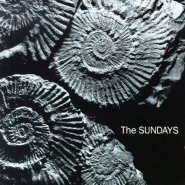
Now here's an album that will probably last me a lifetime or two. This is
their debut album, but originally I got to know The Sundays from their second release (
Blind) via a girl I was madly in love with at the time. Ah, what a girl! she came from Wigan near Manchester, hmm how I cherished her accent and gipsy-like beauty! So whenever I hear
Blind I can't help but think of her... Luckily, though, this pax-post album does not direct my mind to her! And perhaps equally fortunate, this release is --personally speaking-- a better one than The Sundays' second one: the tracks are generally more up-beat and also less "rain-swept England oh crap let's feel sad". Anyway, Harriet Wheeler's vocals are absolutely unique --
ethereal, beautiful-- the guitar work sounds great and the production value is supreme (i.e. all the instruments are so well arranged that it's a joy merely to hear the sounds). Even if you're not into UK indie rock, chances are that this album will enter your heart and soul. If you believe in either of these, of course. The music is sad and happy at the same time, true UK melancholia -- it's no wonder that Robert Burton was an Englishman... Super-recommended, this one! (But make sure you get your equaliser settings right, it's quite important for albums of this kind.)
Sundays_Reading_Writing_Arithmetic_256.rar
V.A. - Headz 2A & 2B (1996)

Mo' Wax is a UK-based record label owned by James Lavelle, who founded it in the early 1990s. The label is most famous for being a purveyor of the "Trip-Hop" sound, although many artists dislike the term, or prefer the broader "abstract hip-hop" tag, if the music must be labeled at all.
Mo' Wax released records by many artists over its years of existence, the most notable being by DJ Shadow, DJ Krush, Andrea Parker, Luke Vibert, Air, Dr. Octagon, Attica Blues, Money Mark, Malcom Catto, Nigo (of Bathing Ape fame), David Axelrod, South, Blackalicious, and Lavelle's own UNKLE. Lavelle made a deal with A&M Records in 1996. Currently, Mo' Wax is part of the Beggars Banquet Group, but there are rumors that the label itself has folded and is no longer putting out new releases.
 Quite a number of reviews I came across weren't too enthousiastic about these four cds, but personally I've never been disappointed with having bought them when they came out in '96. Neither do I mind the tag "Trip Hop" - what's in a word...? This compilation brings you about five hours (I think) of pleasant, chilled out electronic music. As far as I'm concerned, I don't recall there being one bad track on the whole set. I don't think you'll be disappointed with these.
Quite a number of reviews I came across weren't too enthousiastic about these four cds, but personally I've never been disappointed with having bought them when they came out in '96. Neither do I mind the tag "Trip Hop" - what's in a word...? This compilation brings you about five hours (I think) of pleasant, chilled out electronic music. As far as I'm concerned, I don't recall there being one bad track on the whole set. I don't think you'll be disappointed with these.
By the way, I've long been on the lookout for the original Headz, which nowadays is no longer available. So if any of you know where I can get it, or if someone would be so good to upload it for the world, that would be - sweet!
Oh yeah, I think I bungled up A1 & A2 (i.e. gave the folders the wrong names), but you can easily double-check and correct this by consulting the artwork which is provided with the "extra" file. Sorry.
 Headz_II_A1_192.rarHeadz_II_A2_192.rarHeadz_II_B1_192.rarHeadz_II_B2_192.rarHeadz_II_extra.rar
Headz_II_A1_192.rarHeadz_II_A2_192.rarHeadz_II_B1_192.rarHeadz_II_B2_192.rarHeadz_II_extra.rar
Django Reinhardt & Stéphane Grappelli
 Jean Baptiste "Django" Reinhardt
Jean Baptiste "Django" Reinhardt was born into in the open air, rambling lifestyle of his gypsy parents on January 24th, 1910 in Liberchies, Belgium. At the age of eight, his mother's tribe settled near the belt of fortifications that surrounded the old Paris, near the Choisy gate. He never wore a suit or lived in a real house until he was twenty years old. These French Gypsies or Manouches were a world unto themselves, medieval in their beliefs, and distrustful of modern science. Django grew up in this world of contradictions, one foot in the bustling big city of Paris and the other in the age-old life of the nomadic gypsy. Though born into poverty Django had the soul of a nobleman and this natural elegance of bearing and attitude expressed itself in his music.
At the age of 18, Reinhardt was injured in a fire that ravaged the caravan he shared with his first wife. He almost lost a leg, and the third and fourth digits on his left hand (his fretting hand) were burned badly. Reinhardt focused on the guitar and developed an original style of playing that emphasized his undamaged fingers. He was still able to use these two fingers for playing chords, but was unable to use them for playing solos.
In 1934, Louis Vola formed the "Quintette du Hot Club de France" with Reinhardt, violinist Stéphane Grappelli, Reinhardt's brother Joseph and Roger Chaput on guitar, and Louis Vola on bass. As World War II was declared, the quintet was on tour in the United Kingdom. Reinhardt returned to Paris at once, leaving his wife behind. Grappelli remained in the United Kingdom for the duration of the war, and Reinhardt reformed the quintet in Paris with Hubert Rostaing on clarinet in place of Grappelli's violin.
On May 16th 1953 Django suffered a massive brain hemorrhage and died, leaving behind his wife Sophie and son Babik. His music remains as vital and exciting today as it was when he lived, a legacy of joy to all future generations that rediscover the genius of the Belgian gypsy Django Reinhardt.
You can watch some great contemporary
film footage of Django Reinhardt
here.
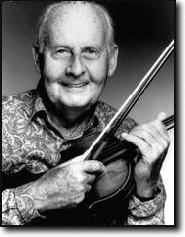 Stéphane Grappelli
Stéphane Grappelli was born on January 26th, 1908 in Paris, France to Italian parents. By the time he was twelve years old, he had acquired his first violin - just one of several instruments he learned to play. He began professionally with theatre bands (including silent films), eventually being introduced to jazz music. Originally self-taught as both a violinist and a pianist, he nevertheless attended the Conservatoire de Paris between 1924 and 1928. Grappelli was a pioneer jazz violinist who founded the quintet of the "Quintette du Hot Club de France" with Django Reinhardt. It was the first all-string jazz band.
They hit it off musically from the start even though their lifestyles (Grappelli was sophisticated while Django was a gypsy) were very different. Together as Quintet of the Hot Club of France (comprised of violin, three acoustic guitars and bass) during 1933-39 they produced a sensational series of recordings and performances.
When World War II commenced, Grappelli and the band were touring Britain. While the others returned to Paris Grappelli decided to stay. During the next six years he became a popular figure in London with habitués of nightlife in general and in musical entertainment in particular, working with local musicians in the local clubs. In 1946, he returned to Paris, renewed association with Reindhart, but the magic of their pre-war days did not reappear too often.
Stéphane Grappelli died aged 89 on December 1st, 1997 in Paris after undergoing a hernia operation. When asked on his 85th birthday if he was considering retirement, Grappelli replied: "Retirement! There isn't a word that is more painful to my ears. Music keeps me going. It has given me everything. It's my fountain of youth."
Souvenirs_Reinhardt_Grapelli.rar (Thanks, sister!)Reinhardt___Grapelli_Swingin_With_Django_CD1_256.rarReinhardt___Grapelli_Swingin_With_Django_CD2_256.rarReinhardt___Grapelli_Swingin_With_Django_CD3_256.rar
Jamaican Riddims
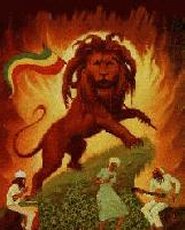
A "riddim", as Jamaican jargon uses it, is a song track of which different vocalists (singers, "toasters) make their own version, each with their own lyrics and vocal melodies. Stricly speaking, a "version" is the naked form of a riddim, containing no vocals. The end of which is, of course, in order to sing along - a bit like the Japanese and their karaoke versions. Whereas most reggae subgenres conceive the riddim as a bass loop combined with a particular drum pattern (exluding the vocals or melodies), others see the (original) melody as also pertaining to the riddim. This is especially true in the case of new-roots reggae.
In the reggae culture there are album releases called "one riddims". These usually contain about a dozen vocal versions and one instrumental. This allows each vocalist to tell his own story. Moreover, each version often contains slight production differences, particularly regarding the beats or rhythm section.
My good friend The Alsomighty Jah-roen has provided me with a fine collection of such riddims. I'll post two albums here, the first being a number of tracks Jah-roen added together himself, the second being a "real" release called
Riddim Driven - Hot Gyal. I'd advise you to turn on "shuffle play" for the former, as it doesn't have a numerical order. Enjoint!

Here's a review about
Riddim Driven - Hot Gyal: One of VP’s latest releases in their Riddim Driven series is the Hot Gyal riddim. This is pure dancehall niceness with performances to inspire dancing. Several tracks have been burning up the place and creating great excitement for the release of the riddim album. Key tracks include “Vibe With Us” by Brian & Tony Gold featuring Bounty Killer, “Hall Of Fame” by Vybz Kartel, “Hol Gal” by Anthony Malvo featuring Capleton and Jah Thunder, and “Marijuana” featuring Sizzla and Jigsy King.
Reggae_Riddims_256-320.rarRiddim_Driven_Hot_Gyal_320.rar
Noise vs Mothers / Mothers vs Noise

A few posts ago I referred to the Experimedia netlabel (
The Rhythm Method), but only recently I discovered something really interesting there. It kind of reminded me of something the philosopher Kierkegaard once brought up: is
angst or boredom (the primal, pre-adolescent root of modern angst) "
terribly tedious" or is it rather "
tediously terrible"? Or, in this case, are "Mothers Against Noise" or is "Noise Against Mothers"? I presume you haven't got a clue what the hell I'm talking about... :-)
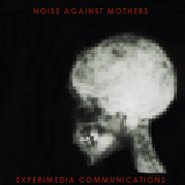
My point is that two different labels have released two separate noise albums that form a very quaint couple. Sweet. Firstly, the
Experimedia release. This is one of those very aggressive, don't-plug-those-tiny-earphones-in-your-ears-or-you'll-go-deaf albums, called
Noise Against Mothers. You have to enjoy hardcore noise in order to appreciate this, I think... Which is not to say that it's not intelligent or interesting music! It's actually really hilarious material! Ooooh my poor, poor neighbours. They must think I'm insane - and even that wouldn't be too far from the truth. But what is truth...?

Secondly, I originally got to know the mother-noise dichotomy from a website that's actually called "
Mothers Against Noise". So the album they provide is called
Mothers Against Noise. Also very noisy, but significantly more beats-based and less psychotic than the Experimedia release. The combination of both releases are a perfect duo of insane sounds. If only one more label would release something along the lines of
Against For Nihiloise (Le style français), then we'd have a brilliant tryptich! Well anyway, I'll provide you with the links, but be prepared for some super-extreme noisy stuff! Aw man, I love it!!! These two albums are some seriously weird shit...
Noise Against MothersMothers Against NoiseIn Dutch/Flemish, we have a word for all this, and I don't know any other language (except for Bushman, which my browser unfortunately doesn't support) that has the same effect for it:
LAWAAI.
Meat Beat Manifesto - Satyricon (1992)
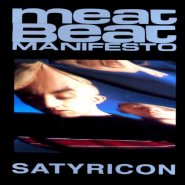
This is a sublimely distressing yet intriguing electronic music album. I found the following review on the net and I think he did a very fine job, so I'll copy-paste it right here:
(very highly recommended!)"Pot sounds? What could that mean! After eliminating any interruptions or distractions put this in the player and listen. Things disappear and the more I see momentarily. Mark at 5, 4, 3, 2, 1 Drop. I honestly think that can be taken in a literal sense. And if you do drop, prepare for intensity. Its rather a dipping ride to get use to. Do you accept your existence and acquire it with a certain peace of mind? "Well, I except my existence, hum, I don't accept the situation that I find my self in on this planet. No. I think thats a real struggle." a situation being? "That I live in a culture which is permeated by dominance and oppression, ah, not only with in my culture but around the world." "I think that there is a rebelitory experience awaiting everyone that has to do with finding out who and what they really are. And when that occurs, if it occurs you have reached nirvana/heaven. And to the degree which you don't reach that place or realization you are in eternal hell." Is this the person speaking who has abandoned hes origins? What do you want from the rest of your life? Are you afraid of death? "I have seen people killed, and ah, thats showbiz." "Lose your mind, your soul, control, then your body!" "At the end there will be nothing. No atoms, no molecules, no subatomic particles. No thing at all. Nothing. At the end." Do you live on in some way after death? This album could really cause a unstable person some mental problems. Anyone else capable of reason could find this album challenging. Of course, you have to like interesting music to begin with." (Chilly D from Oklahoma City, USA)
Turn this fucker way up to eleven and let it flow right through your disintegrating mind!
Meat_Beat_Manifesto_Satyricon_192.rar
Quotecorpse

As cool as the pale wet leaves
of lily-of-the-valley
she lay beside me in the dawn.
Ezra Pound, 1915
V.A. - The Rhythm Method (EXP036)
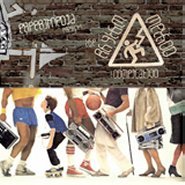
Strictly speaking, this isn't really a post of mine, but a recent release by the
netlabel Experimedia. I downloaded it last night, have been listening to it for the last two hours or so - and found it so crammed with interesting tunes that I wanted to refer all you eclecticelectelectric music lovers to it. Yep, it's recommended!
"First Experimedia
unleashed a collection of lush ambient soundscapes, to commemorate their 25th release. Then they unveiled an abrassive noise compilation, aimed at proprietors of artistic censorship. And now, Experimedia returns with their greatest compilation yet... the double LP-length
Rhythm Method, featuring
close to 160 minutes of new & exclusive music from mostly new and/or unheard artists. Thematically, this release continues the tradition of attacking a specific niche of electronica, with the focus now on
beat-driven electro, squelchy glitch-hop, raw and rugged d'n'b... basically, if it has a pulse, it is being represented. Whether you like to dance, nod yer head, or just sit back and chill to some ear candy... this is for you. Design by Jack Rabbit."
The Rhythm Method (EXP036)
Stabat Mater Dolorosa - Pergolesi, Scarlatti & Vivaldi

Here's a trio of
Stabat Maters I've long been wanting to post; the fact my previous post contains one track bearing the same title gave me the chance to follow up in a consistent fashion. The
Stabat Mater is an absolute personal favourite when it comes to the sublime cantate art form. Hope you like them!
Giovanni Battista Pergolesi (1710 – 1736)
Alessandro Scarlatti (1660 – 1725)
Antonio Vivaldi (1678 – 1741)
 The Stabat Mater Hymns
The Stabat Mater Hymns
The opening words of two companion hymns, one of which (
Stabat Mater Dolorosa) is in liturgical use, while the other (
Stabat Mater Speciosa) is not. They celebrate the emotions of Our Lady at the Cross and at the Manger -- Calvary and Bethlehem -- respectively, and may conveniently be differentiated here by the third word (
Dolorosa, Speciosa). The Speciosa contains thirteen (double) stanzas of six lines; the
Dolorosa, ten. In what follows only the
Stabat Mater Dolorosa will be dealt with.
The hymn was well known to all classes by the end of the fourteenth century. If the very questionable ascription to Jacopone da Todi is correct, the hymn probably found its way from Franciscan houses into those of other religious bodies and into popular use. It is found in several European (but not English) Missals of the fifteenth century, but was not introduced into the Roman Breviary and Missal until 1727 (Feast of the Seven Dolours B. V. M., assigned to Friday after Passion Sunday).
The authorship of the hymn has been ascribed to a number of men, the most probable being Pope Innocent III (one of the greatest popes of the Middle Ages, born 1160 or 1161 and died 16 June 1216) and Jacopone da Todi, more properly called Jacopo Benedetti (a Franciscan poet, born in the first half of the thirteenth century and died about 1306).
A large literature has grown about the hymns, Protestants sharing with Catholics a deep, and often glowingly expressed, admiration for its pathos, its vividness of description, its devotional sweetness and unction, its combination of easy rhythmic flow with exquisite double rhyming and finished stanzaic form. Because of its vividly epic and lyric character, the hymn has received multiform musical setting. There are literally hundreds of versions extant, as you can discover on
a website created by the recently deceased Dutchman Hans van der Velden, who personally owned 211
Stabat Mater cds.
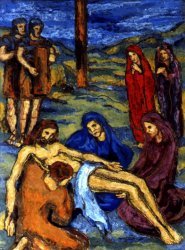 Pergolesi & Scarlatti
Pergolesi & Scarlatti
Pergolesi’s health already undermined by a form of tuberculosis, he was being cared for at a Fransiscan monastery in Pozzuoli where he worked at the score of his last piece, the Stabat Mater, putting the final touches to it only days before his death on 16 March 1736. He was 26. His
Stabat Mater had become a symbol of the perfection and universality of Italian music – “Such is the fascination of Italian music that when you listen to it you desire no greater happiness in the world,” wrote Charles de Brosses (influential C18 French intellectual).
Scarlatti was less fortunate, having to pay the price of all who are left behind by changes of taste and fashion. His
Stabat Mater lost out simply for being informed by his innate qualities of scholarship and profound musicianship.
Whereas Pergolesi tends to reduce and differentiation of voices and instruments, allowing increasingly pure, simple melody, Scarlatti’s predilection for extremely dense textures and for harmony rather than melody (the latter being the more “modern” style at the beginning of C18) often led to ingenious polyphonic and contrapunctal development.
To help you compare these two brilliant yet divergent artists, I’ve scanned in the texts of the hyms, which are identical in both versions. This way you can compare for yourself the way both composers illustrate, e.g. the sword-blows (#2, #14) or the death sight (#6, #20), or any other stanza you would like to delve deeper into.
Finally, whereas in both cases castrati would almost certainly have been used in the original performances, the choice in this recording fell on two female voices (Sara Mingardo – contralto; Gemma Bertagnolli – soprano). The conductor, Rinaldo Alessandrini, felt that the closest thing to the now-vanished castrato the modern world possesses, i.e. the countertenor voice, was completely unknown at the time, or at least was never heard in a solo situation, and would therefore entail minimal fidelity to the sound world of the castrato.
 Vivaldi
Vivaldi
The priest Vivaldi, in view of his wild red hair often called "the red priest" (Il Preto Rosso), worked the largest part of his life as a music master at the Ospedale della Pietà in Venice, originally an orphanage for extra-marital girls. For an important part this may not only have influenced the score of his works (there were only women to play and sing), but could also be the reason for the fact that he frequently made use of easy to listen to melodies, as these were mostly intended for a young female audience.
Vivaldi set only the more dramatic, first half of the
Stabat Mater. His selection of an alto soloist gives the work a suitably dark timbre. Although he wrote a large volume of vocal and instrumental works for an orphanage of young women where he long directed musical activities, this work was apparently written for one of the hundreds of castrati employed in Italian churches at this time. Vivaldi repeats the music of the first three movements for the next three — with no obvious textual reason. Was he seeking a quick way to fulfill a commission or using repetition for musical purposes, or both? In any case, the result is satisfying.
Vivaldi’s intricate writing for strings — famous from his
Four Seasons — is evident here as well, most notably in the “Eia Mater” movement. Its persistent, weeping violin figure serves as a counterpoint to the lyrical vocal line. “Fac ut ardeat cor meum” provides a sweet contrast with a swinging, lullaby-like effect that suggests a mother’s love. Also interesting is the whipping figure in the third and sixth movements, and the stabbing chords underpinning the second and fifth movements — both vividly evoke the suffering of Mary at the foot of the cross.
Concerto_Italiano_Rinaldo_Allessandrini_256.part1.rarConcerto_Italiano_Rinaldo_Allessandrini_256.part2.rarAntonio_Vivaldi_Gloria___Stabat_Mater_256.rar
Cuncordu de Orosei - Miserere (1998)
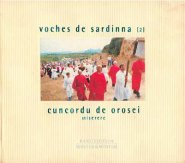
Here's a very special album my lovely sister uploaded for me a few days ago, and wow! it's sending shivers down my spine and inducing a strangely emotional effect on me. This is very affective material containing
Sardinian vocal harmonies (from the island of Sardegna, Italy). I've copied the information below from a very informative
website:
By their intensity, there is no doubt that Sardinian songs are one of the most popular expressions of vocal harmonies in the Mediterranean. They are heard everywhere, as much in religious liturgy as in peasant festivals, occupying as they do the
frontier between the secular and sacred music. The group Cuncordu e Tenore de Orosei is famous as one of the most representative of this vocal Sardinian art because they excel at both sacred and secular "A Tenore".
The raspy voices of these five men seem to rise from the very center of the earth… from the land of Sardinia, whose oral heritage is of priceless universal value. As they take their music through other lands, they are careful to protect and restore this musical wealth. The thrill of listening to these vocal harmonies is simple and direct like these men, who know how to share them and
touch their audiences in the depths of their souls.
Artists
- Patrizio Mura Voche del tenore e del cuncordu (the voice on tenore and sacred)
- Piero Pala Mesuvoche del tenore e del cuncordu (baryton)
- Massimo Roych Voche del Cuncordu (the voice on sacred)
- Mario Siotto Bassu del tenore e del cuncordu (rythmical basis)
- Gianluca Frau Contra del tenore e del cuncordu (rythmical basis)
Tracks - Sendhe Mortu Chin Rigore (5:14)
- Tzeleste Tesoro (4:48)
- Miserere (4:52)
- Gotzos De Sant'Antoni 'E S'ocu (2:50)
- Stabat Mater (5:32)
- O Vizu Meu Istimadu (6:14)
- Libera Me, Domine (3:54)
- Sendhe In Sa Rughe Incravadu (5:20)
- Ave Maria (6:33)
- Magnificat De S'Incontru (7:08)
- Gotzos De Sun Nefressariu (4:12)
- Sa Seportura Santa (5:13)
- O Viv'arbore Fiorida (4:55)
Total time: 1:06:45
Cuncordu_de_Orosei_Miserere.rar (192 kbps)
Rachid Taha - Diwân (1998)

Rachid Taha is an incredibly talented and versatile
Franco-Algerian rock-raï artist, born in Oran, Algeria (1958) but having grown up in the dark "traboules" (tiny streets of the old city) of Lyon, France. He's often attributed the epithet "rock-beur" (a pun mixing rocker and "beur", i.e. second generation migrant) and his albums truthfully reflect that.
Diwân, Taha's fourth solo album, differs from his previous releases in that it contains less rock music and features
more traditional arabic instruments and arrangements. Many of the songs are about the founding fathers of raï music, and the lyrics are in Arabic and French. The music is very uplifting and is one of my favourites in the modern arab-oriental genre. You can find out a lot more about Rachid Taha and his releases
here.
Highly recommended! I would also recommend
1,2,3 Soleil, a live album he did together with Faudel and Khaled, both also raï masters. Another interesting detail I just discovered:
Diwân, as well as Taha's latest album
Tekitoi?, was produced by
Steve Hillage - a great artist whom I know from his superb 1978 psychedelic guitar album
Green which, incidentally, you can find on one of the b-logs on the right (I can't remember which one, sorry).
Tracks
- Ya Rayah (6:27)
- Ida (7:03)
- Habina (4:34)
- Bent Sahra (7:13)
- Ach Adani (6:09)
- El H'Mame (7:00)
- Enti Rahti (7:28)
- Menfi (5:58)
- Bani Al Insane (6:15)
- Malheureux Toujours (5:05)
- Aiya Aiya (6:13)
Total time: 1:09:25
Rachid_Taha_Diwân_192.rar (Updated link!)
Should I stop using Rapidshare?

Drop a bird-note turd-note and I'll try to take it into kontsidderatio. :-)
Not your cup of quotetea?

Who has no faith, the ungrateful one,
The man who is a burglar,
Who has destroyed opportunities, ejected wish,
Truly he is a person supreme.
The Buddha,
Dhammapada, ca. 500 B.C.
Without a jot of ambition left
I let my nature flow where it will.
There are ten days of rice left in my bag
And, by the hearth, a bundle of firewood.
Who prattles of illusion or nirvana?
Forgetting the equal dusts of name and fortune,
Listening to the night rain on the roof of my hut,
I sit at ease, both legs stretched out.
Ryokan, 1757-1831 (transl. Lucien Stryk & Takashi Ikemoto)
Automaton - Jihad: Points of Order (1994)

I know very, very little about the "band" called Automaton, but the liner notes mention Nicky Skopelitis (guitar, treatments), Lili Haydn (violin), Tetsu Inoue (electronics), Bill Laswell (bass, beats) and Robert Musso (treatments). And no, it's not Robert Mosuse. Moreover, the whole album was produced by Bill Laswell. I thought I'd post this one especially for that anonymous figure who appears so enthralled by anything Mr Laswell undertakes. Fine with me! Some of you regulars of this b-log may have noticed that the abovementioned names also appear on the ambient compendium I posted earlier. Well, this release contains two tracks of about 23 minutes each, one of which features as a remix on the same compendium - but not to worry, it's not the same track! Anyway, what you get is some
spaced out, detailed ambient music, so I hope you've got a pair of decent headphones or some very tolerant neighbours. :-)
Tracks
- Port of Entry (The Future Is Within Control) (23:49)
- Intersection Point Between Empty Desert and Written Deserts (23:07)
Automaton_Jihad_Points_of_Order_256.rar
Klaus Hess - Technodrome (1992)

Those who are into German prog rock may recognise Klaus Hess as the ex-guitar player of the
rock band Jane (I think you can find some albums by them if you check out the b-log links on the right). After Jane, Hess went solo, producing
Sternentanz in 1983 which is space rock, and in 1992
Technodrome, a somewhat strange and dated
electronic album. Fans of early electro/industrial may enjoy this. Personally, this isn't one of my favourites, but nevertheless it makes an interesting listen, perhaps due to the fact that it sounds so dated. It seems more like mid to late 80s electronic music rather than early 90s...
Tracks
- Technodrome (5:39)
- Out of Area (5:48)
- Sirius (5:37)
- Opus (1:22)
- City of 2010 (5:47)
- Halleluja (6:24)
- Rainbow Warrior (4:22)
- Heartbeat (1:45)
- Orion (8:36)
Total time: 45:32
Klaus_Hess_Technodrome_256.rar
Pete Namlook - Air 2 (1994)
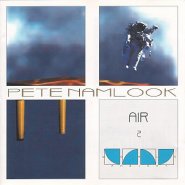
Pete Namlook is one of the great masters of extreme
ambient music, worthy to be placed beside the likes of Bill Laswell (with whom he has cooperated at times). The tracks are fairly minimalistic with a definitive
mystical (transcendental) atmosphere. I don't have too much to say about this album, as I only recently found it on my hard disk - and have no idea where it came from! Ah, the wonders of modern technology... I won't print a tracklist here, as all eleven tracks (totalling to about one hour) are simply titled "Trip #". Ambient fans will probably like this release. And if you ever see stuff by Namlook in a shop, don't hesitate to buy it!
Pete_Namlook_Air_2_128.rar
Quotepie with neeps 'n' tatties
I see these strange tools, my hands, at the end of my arms; I see these strange tools, my arms, that hang from my shoulders; I see these strange tools, my shoulders, that curve from my neck; I see this strange tool, my neck, that carries my head; I see this strange tool, my head, that holds my brain; I see this strange tool, my brain, that sees itself and calls itself a tool and tries to find in itself a thing not a tool that it is a tool for.
John Fowles,
The Aristos (1964)
The Weakener - What do you know about it (1998)
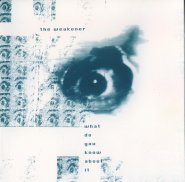
I found this very strange album in my local cd shop about a month ago. It holds seven fairly long tracks, all created and mixed by
M.J. Harris - some of you will know him from Scorn (see below and visit MoogPower) and, of course, Napalm Death. Which does not go as far as to say that you will like this release if you like either of the other two. The dubby feel of Scorn is no longer here: instead, Harris experiments with rhythms reminiscent of
trip hop, also using many counterbeats to unsettle your expectations. What struck me most of all are the
disturbing basslines, which on all tracks express something like lethargy or extreme boredom - highly claustrophobic, in fact. Harris' use of samples, though, is instantly recognisable (compare with Scorn). And interestingly, the liner notes once again mention Bill Laswell (see below as well). Not for everyone's pleasure, I presume, but worth giving a try as I haven't heard anything like this before. Note: I've had to upload the artwork separately as I had forgotten to add it to the original compressed file.
This one's for da MoogPower!Tracks
- Spotter (6:33)
- Closed door (9:39)
- Know nothing (6:06)
- Pinging (8:22)
- 50 route (6:39)
- This place (5:42)
- Silent dust (7:53)
The_Weakener_What_Do_You_Know_About_It_256.rarWeakener_Artwork.rar
Tek9 - Simply (1999)

This is Tek9's second full length album, delivering quality hip hop from Dollis Hill featuring rap artists from both sides of the Atlantic, including Dego from 4hero (jungle music). Filled with great beats and intelligent (and often funny) lyrics. Don't know much about the band - only that this is not Wu-Tang style hip hop. Which means the same as 'pretty good & chilled out'! Enjoy!!
Tracks
- Teknology (4:19)
- Stand Clear (3:32)
- Keep It Hot (3:44)
- Off License (3:32)
- Gus Interlude (1:13)
- Black Expedition (3:52)
- 2001 (3:49)
- Bruklon (4:02)
- Interlude 2 (2:01)
- Right Position (6:06)
- Seven Days (3:47)
- Bad Baad (4:06)
Total time: 44:03
Tek9_Simply_256.rar
Digable Planets - Blowout Comb (1994)

Without a doubt the finest hip hop I've ever come across, this 1994 release by a trio from New York has been a steady audio friend during the last decade. Wow, this album is so smooth, filled with ultra-chilled beats, luscious basses, superb use of samples and impeccable rapping. The lyrics are often inspired by the revolutionary Black Panthers, but the feeling of the album is the opposite of aggressive. Even if you're not into rap or hip hop, you will like this music as it fully ignores the boundaries between
soul, jazz and hip hop. This is the band's second and last release - if you can get your hands on their first album, get it - it's different from this one, but well worth the purchase. So light up a big joint, lie back and enjoy this timeless classic!
Tracks
- May 4th Movement (4:56)
- Black Ego (7:02)
- Dog It (4:21)
- Jettin' (4:39)
- Borough Check (6:56)
- Highing Fly (1:23)
- Dial 7 (Axion of Creamy Spies) (5:47)
- Art of Easing (5:06)
- K.B.'s Alley (Mood Dudes Groove) (2:06)
- Graffiti (4:03)
- Blowing Down (3:51)
- 9th Wonder (Blackitolism) (4:27)
- For Corners (7:02)
Total time: 1:01:31
Digable_Planets_Blowout_Comb_256.part1.rarDigable_Planets_Blowout_Comb_256.part2.rar
Pax Diero - Hierusalaam

Until about a year ago I used to experiment with sounds and rhythms, mainly using a program called Cakewalk. But then I had to format my C drive coz I dabbled around in my BIOS - yes it's stupid, but hey,
the richer the nature, the more the squandering! The program is now irretrievably lost, but recently I found some wav files I had exported my music into. So I thought, why not convert them to mp3 and upload them to this b-log? I've placed a total of ten tracks in two folders: upbeat and downbeat. Personally I like the downbeat folder most; the upbeat tracks are generally not quite finished. You can hear Homer saying weird things on one, another is a remix of Nancy Wilson's "Moon River" (my favourite, I think), and one track has a bunch of whales singing together (it's a very sad track, though - I see it as the swansong of the whales going extinct). You won't like all of it, but I've got good reasons to believe that overally (especially the downbeat section) these tracks are great fun to listen to.
I'd love to hear your feedback and hopefully I can get my hands on another sequencing program so I can start playing around with sounds again.
Downbeat
- Scribbles (5:02)
- Crystal (2:43)
- Beatnix (4:57)
- Moon River (3:56)
- Rain Whales (4:49)
Upbeat
- Dropoh (3:19)
- Skaalskool (5:27)
- Phiewiew (3:43)
- Warp (4:07)
- Waves (6:34)
PaxDiero_Hierusalaam_256.rar
The Orb - Orblivion (1997) and Cydonia (2001)
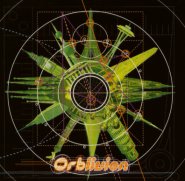
To continue along the lines of FSOL, I think The Orb suits splendidly. I'm in a bit of a hurry at the moment, as it's nice and warm outside - and things like that tend not to last too long here! According to most
Orblivion is the better of the two albums posted just here, but I think that's more due to listeners' expectations of The Orb's earlier releases than an objective approach to either album. Fact remains, though, that
Orblivion is definitely
more psychedelic and experimental. Also lots of humour, and the part where the UK northerner speaks about Tjernobyl still freaks me out - can't help it...

The album The Orb released next,
Cydonia (the name probably refers to a region in the northern hemisphere of Mars), has
stronger elements of dub and dance music. What really sets this album apart from any of The Orb's earlier releases is that a lot of tracks use
a superb female vocalist. (Sorry for the glitch at second five...) So here you have two very different albums from a great artist. I don't doubt for a second that most of you will like these. Enjoyez vous, as rather nobody says in Belgium!
Orb_Orblivion_256_vbr.part1.rar Orb_Orblivion_256_vbr.part2.rarOrb_Cydonia_256_vbr.part1.rarOrb_Cydonia_256_vbr.part2.rar
 Now here's an album that will probably last me a lifetime or two. This is their debut album, but originally I got to know The Sundays from their second release (Blind) via a girl I was madly in love with at the time. Ah, what a girl! she came from Wigan near Manchester, hmm how I cherished her accent and gipsy-like beauty! So whenever I hear Blind I can't help but think of her... Luckily, though, this pax-post album does not direct my mind to her! And perhaps equally fortunate, this release is --personally speaking-- a better one than The Sundays' second one: the tracks are generally more up-beat and also less "rain-swept England oh crap let's feel sad". Anyway, Harriet Wheeler's vocals are absolutely unique --ethereal, beautiful-- the guitar work sounds great and the production value is supreme (i.e. all the instruments are so well arranged that it's a joy merely to hear the sounds). Even if you're not into UK indie rock, chances are that this album will enter your heart and soul. If you believe in either of these, of course. The music is sad and happy at the same time, true UK melancholia -- it's no wonder that Robert Burton was an Englishman... Super-recommended, this one! (But make sure you get your equaliser settings right, it's quite important for albums of this kind.)
Now here's an album that will probably last me a lifetime or two. This is their debut album, but originally I got to know The Sundays from their second release (Blind) via a girl I was madly in love with at the time. Ah, what a girl! she came from Wigan near Manchester, hmm how I cherished her accent and gipsy-like beauty! So whenever I hear Blind I can't help but think of her... Luckily, though, this pax-post album does not direct my mind to her! And perhaps equally fortunate, this release is --personally speaking-- a better one than The Sundays' second one: the tracks are generally more up-beat and also less "rain-swept England oh crap let's feel sad". Anyway, Harriet Wheeler's vocals are absolutely unique --ethereal, beautiful-- the guitar work sounds great and the production value is supreme (i.e. all the instruments are so well arranged that it's a joy merely to hear the sounds). Even if you're not into UK indie rock, chances are that this album will enter your heart and soul. If you believe in either of these, of course. The music is sad and happy at the same time, true UK melancholia -- it's no wonder that Robert Burton was an Englishman... Super-recommended, this one! (But make sure you get your equaliser settings right, it's quite important for albums of this kind.)
 Mo' Wax is a UK-based record label owned by James Lavelle, who founded it in the early 1990s. The label is most famous for being a purveyor of the "Trip-Hop" sound, although many artists dislike the term, or prefer the broader "abstract hip-hop" tag, if the music must be labeled at all.
Mo' Wax is a UK-based record label owned by James Lavelle, who founded it in the early 1990s. The label is most famous for being a purveyor of the "Trip-Hop" sound, although many artists dislike the term, or prefer the broader "abstract hip-hop" tag, if the music must be labeled at all. Quite a number of reviews I came across weren't too enthousiastic about these four cds, but personally I've never been disappointed with having bought them when they came out in '96. Neither do I mind the tag "Trip Hop" - what's in a word...? This compilation brings you about five hours (I think) of pleasant, chilled out electronic music. As far as I'm concerned, I don't recall there being one bad track on the whole set. I don't think you'll be disappointed with these.
Quite a number of reviews I came across weren't too enthousiastic about these four cds, but personally I've never been disappointed with having bought them when they came out in '96. Neither do I mind the tag "Trip Hop" - what's in a word...? This compilation brings you about five hours (I think) of pleasant, chilled out electronic music. As far as I'm concerned, I don't recall there being one bad track on the whole set. I don't think you'll be disappointed with these.
 Jean Baptiste "Django" Reinhardt was born into in the open air, rambling lifestyle of his gypsy parents on January 24th, 1910 in Liberchies, Belgium. At the age of eight, his mother's tribe settled near the belt of fortifications that surrounded the old Paris, near the Choisy gate. He never wore a suit or lived in a real house until he was twenty years old. These French Gypsies or Manouches were a world unto themselves, medieval in their beliefs, and distrustful of modern science. Django grew up in this world of contradictions, one foot in the bustling big city of Paris and the other in the age-old life of the nomadic gypsy. Though born into poverty Django had the soul of a nobleman and this natural elegance of bearing and attitude expressed itself in his music.
Jean Baptiste "Django" Reinhardt was born into in the open air, rambling lifestyle of his gypsy parents on January 24th, 1910 in Liberchies, Belgium. At the age of eight, his mother's tribe settled near the belt of fortifications that surrounded the old Paris, near the Choisy gate. He never wore a suit or lived in a real house until he was twenty years old. These French Gypsies or Manouches were a world unto themselves, medieval in their beliefs, and distrustful of modern science. Django grew up in this world of contradictions, one foot in the bustling big city of Paris and the other in the age-old life of the nomadic gypsy. Though born into poverty Django had the soul of a nobleman and this natural elegance of bearing and attitude expressed itself in his music. Stéphane Grappelli was born on January 26th, 1908 in Paris, France to Italian parents. By the time he was twelve years old, he had acquired his first violin - just one of several instruments he learned to play. He began professionally with theatre bands (including silent films), eventually being introduced to jazz music. Originally self-taught as both a violinist and a pianist, he nevertheless attended the Conservatoire de Paris between 1924 and 1928. Grappelli was a pioneer jazz violinist who founded the quintet of the "Quintette du Hot Club de France" with Django Reinhardt. It was the first all-string jazz band.
Stéphane Grappelli was born on January 26th, 1908 in Paris, France to Italian parents. By the time he was twelve years old, he had acquired his first violin - just one of several instruments he learned to play. He began professionally with theatre bands (including silent films), eventually being introduced to jazz music. Originally self-taught as both a violinist and a pianist, he nevertheless attended the Conservatoire de Paris between 1924 and 1928. Grappelli was a pioneer jazz violinist who founded the quintet of the "Quintette du Hot Club de France" with Django Reinhardt. It was the first all-string jazz band. A "riddim", as Jamaican jargon uses it, is a song track of which different vocalists (singers, "toasters) make their own version, each with their own lyrics and vocal melodies. Stricly speaking, a "version" is the naked form of a riddim, containing no vocals. The end of which is, of course, in order to sing along - a bit like the Japanese and their karaoke versions. Whereas most reggae subgenres conceive the riddim as a bass loop combined with a particular drum pattern (exluding the vocals or melodies), others see the (original) melody as also pertaining to the riddim. This is especially true in the case of new-roots reggae.
A "riddim", as Jamaican jargon uses it, is a song track of which different vocalists (singers, "toasters) make their own version, each with their own lyrics and vocal melodies. Stricly speaking, a "version" is the naked form of a riddim, containing no vocals. The end of which is, of course, in order to sing along - a bit like the Japanese and their karaoke versions. Whereas most reggae subgenres conceive the riddim as a bass loop combined with a particular drum pattern (exluding the vocals or melodies), others see the (original) melody as also pertaining to the riddim. This is especially true in the case of new-roots reggae. Here's a review about Riddim Driven - Hot Gyal: One of VP’s latest releases in their Riddim Driven series is the Hot Gyal riddim. This is pure dancehall niceness with performances to inspire dancing. Several tracks have been burning up the place and creating great excitement for the release of the riddim album. Key tracks include “Vibe With Us” by Brian & Tony Gold featuring Bounty Killer, “Hall Of Fame” by Vybz Kartel, “Hol Gal” by Anthony Malvo featuring Capleton and Jah Thunder, and “Marijuana” featuring Sizzla and Jigsy King.
Here's a review about Riddim Driven - Hot Gyal: One of VP’s latest releases in their Riddim Driven series is the Hot Gyal riddim. This is pure dancehall niceness with performances to inspire dancing. Several tracks have been burning up the place and creating great excitement for the release of the riddim album. Key tracks include “Vibe With Us” by Brian & Tony Gold featuring Bounty Killer, “Hall Of Fame” by Vybz Kartel, “Hol Gal” by Anthony Malvo featuring Capleton and Jah Thunder, and “Marijuana” featuring Sizzla and Jigsy King. A few posts ago I referred to the Experimedia netlabel (The Rhythm Method), but only recently I discovered something really interesting there. It kind of reminded me of something the philosopher Kierkegaard once brought up: is angst or boredom (the primal, pre-adolescent root of modern angst) "terribly tedious" or is it rather "tediously terrible"? Or, in this case, are "Mothers Against Noise" or is "Noise Against Mothers"? I presume you haven't got a clue what the hell I'm talking about... :-)
A few posts ago I referred to the Experimedia netlabel (The Rhythm Method), but only recently I discovered something really interesting there. It kind of reminded me of something the philosopher Kierkegaard once brought up: is angst or boredom (the primal, pre-adolescent root of modern angst) "terribly tedious" or is it rather "tediously terrible"? Or, in this case, are "Mothers Against Noise" or is "Noise Against Mothers"? I presume you haven't got a clue what the hell I'm talking about... :-)

 This is a sublimely distressing yet intriguing electronic music album. I found the following review on the net and I think he did a very fine job, so I'll copy-paste it right here: (very highly recommended!)
This is a sublimely distressing yet intriguing electronic music album. I found the following review on the net and I think he did a very fine job, so I'll copy-paste it right here: (very highly recommended!)
 Strictly speaking, this isn't really a post of mine, but a recent release by the netlabel Experimedia. I downloaded it last night, have been listening to it for the last two hours or so - and found it so crammed with interesting tunes that I wanted to refer all you eclecticelectelectric music lovers to it. Yep, it's recommended!
Strictly speaking, this isn't really a post of mine, but a recent release by the netlabel Experimedia. I downloaded it last night, have been listening to it for the last two hours or so - and found it so crammed with interesting tunes that I wanted to refer all you eclecticelectelectric music lovers to it. Yep, it's recommended!



 Here's a very special album my lovely sister uploaded for me a few days ago, and wow! it's sending shivers down my spine and inducing a strangely emotional effect on me. This is very affective material containing Sardinian vocal harmonies (from the island of Sardegna, Italy). I've copied the information below from a very informative
Here's a very special album my lovely sister uploaded for me a few days ago, and wow! it's sending shivers down my spine and inducing a strangely emotional effect on me. This is very affective material containing Sardinian vocal harmonies (from the island of Sardegna, Italy). I've copied the information below from a very informative  Rachid Taha is an incredibly talented and versatile Franco-Algerian rock-raï artist, born in Oran, Algeria (1958) but having grown up in the dark "traboules" (tiny streets of the old city) of Lyon, France. He's often attributed the epithet "rock-beur" (a pun mixing rocker and "beur", i.e. second generation migrant) and his albums truthfully reflect that. Diwân, Taha's fourth solo album, differs from his previous releases in that it contains less rock music and features more traditional arabic instruments and arrangements. Many of the songs are about the founding fathers of raï music, and the lyrics are in Arabic and French. The music is very uplifting and is one of my favourites in the modern arab-oriental genre. You can find out a lot more about Rachid Taha and his releases
Rachid Taha is an incredibly talented and versatile Franco-Algerian rock-raï artist, born in Oran, Algeria (1958) but having grown up in the dark "traboules" (tiny streets of the old city) of Lyon, France. He's often attributed the epithet "rock-beur" (a pun mixing rocker and "beur", i.e. second generation migrant) and his albums truthfully reflect that. Diwân, Taha's fourth solo album, differs from his previous releases in that it contains less rock music and features more traditional arabic instruments and arrangements. Many of the songs are about the founding fathers of raï music, and the lyrics are in Arabic and French. The music is very uplifting and is one of my favourites in the modern arab-oriental genre. You can find out a lot more about Rachid Taha and his releases 

 I know very, very little about the "band" called Automaton, but the liner notes mention Nicky Skopelitis (guitar, treatments), Lili Haydn (violin), Tetsu Inoue (electronics), Bill Laswell (bass, beats) and Robert Musso (treatments). And no, it's not Robert Mosuse. Moreover, the whole album was produced by Bill Laswell. I thought I'd post this one especially for that anonymous figure who appears so enthralled by anything Mr Laswell undertakes. Fine with me! Some of you regulars of this b-log may have noticed that the abovementioned names also appear on the ambient compendium I posted earlier. Well, this release contains two tracks of about 23 minutes each, one of which features as a remix on the same compendium - but not to worry, it's not the same track! Anyway, what you get is some spaced out, detailed ambient music, so I hope you've got a pair of decent headphones or some very tolerant neighbours. :-)
I know very, very little about the "band" called Automaton, but the liner notes mention Nicky Skopelitis (guitar, treatments), Lili Haydn (violin), Tetsu Inoue (electronics), Bill Laswell (bass, beats) and Robert Musso (treatments). And no, it's not Robert Mosuse. Moreover, the whole album was produced by Bill Laswell. I thought I'd post this one especially for that anonymous figure who appears so enthralled by anything Mr Laswell undertakes. Fine with me! Some of you regulars of this b-log may have noticed that the abovementioned names also appear on the ambient compendium I posted earlier. Well, this release contains two tracks of about 23 minutes each, one of which features as a remix on the same compendium - but not to worry, it's not the same track! Anyway, what you get is some spaced out, detailed ambient music, so I hope you've got a pair of decent headphones or some very tolerant neighbours. :-) Those who are into German prog rock may recognise Klaus Hess as the ex-guitar player of the rock band Jane (I think you can find some albums by them if you check out the b-log links on the right). After Jane, Hess went solo, producing Sternentanz in 1983 which is space rock, and in 1992 Technodrome, a somewhat strange and dated electronic album. Fans of early electro/industrial may enjoy this. Personally, this isn't one of my favourites, but nevertheless it makes an interesting listen, perhaps due to the fact that it sounds so dated. It seems more like mid to late 80s electronic music rather than early 90s...
Those who are into German prog rock may recognise Klaus Hess as the ex-guitar player of the rock band Jane (I think you can find some albums by them if you check out the b-log links on the right). After Jane, Hess went solo, producing Sternentanz in 1983 which is space rock, and in 1992 Technodrome, a somewhat strange and dated electronic album. Fans of early electro/industrial may enjoy this. Personally, this isn't one of my favourites, but nevertheless it makes an interesting listen, perhaps due to the fact that it sounds so dated. It seems more like mid to late 80s electronic music rather than early 90s... Pete Namlook is one of the great masters of extreme ambient music, worthy to be placed beside the likes of Bill Laswell (with whom he has cooperated at times). The tracks are fairly minimalistic with a definitive mystical (transcendental) atmosphere. I don't have too much to say about this album, as I only recently found it on my hard disk - and have no idea where it came from! Ah, the wonders of modern technology... I won't print a tracklist here, as all eleven tracks (totalling to about one hour) are simply titled "Trip #". Ambient fans will probably like this release. And if you ever see stuff by Namlook in a shop, don't hesitate to buy it!
Pete Namlook is one of the great masters of extreme ambient music, worthy to be placed beside the likes of Bill Laswell (with whom he has cooperated at times). The tracks are fairly minimalistic with a definitive mystical (transcendental) atmosphere. I don't have too much to say about this album, as I only recently found it on my hard disk - and have no idea where it came from! Ah, the wonders of modern technology... I won't print a tracklist here, as all eleven tracks (totalling to about one hour) are simply titled "Trip #". Ambient fans will probably like this release. And if you ever see stuff by Namlook in a shop, don't hesitate to buy it! I found this very strange album in my local cd shop about a month ago. It holds seven fairly long tracks, all created and mixed by M.J. Harris - some of you will know him from Scorn (see below and visit MoogPower) and, of course, Napalm Death. Which does not go as far as to say that you will like this release if you like either of the other two. The dubby feel of Scorn is no longer here: instead, Harris experiments with rhythms reminiscent of trip hop, also using many counterbeats to unsettle your expectations. What struck me most of all are the disturbing basslines, which on all tracks express something like lethargy or extreme boredom - highly claustrophobic, in fact. Harris' use of samples, though, is instantly recognisable (compare with Scorn). And interestingly, the liner notes once again mention Bill Laswell (see below as well). Not for everyone's pleasure, I presume, but worth giving a try as I haven't heard anything like this before. Note: I've had to upload the artwork separately as I had forgotten to add it to the original compressed file.
I found this very strange album in my local cd shop about a month ago. It holds seven fairly long tracks, all created and mixed by M.J. Harris - some of you will know him from Scorn (see below and visit MoogPower) and, of course, Napalm Death. Which does not go as far as to say that you will like this release if you like either of the other two. The dubby feel of Scorn is no longer here: instead, Harris experiments with rhythms reminiscent of trip hop, also using many counterbeats to unsettle your expectations. What struck me most of all are the disturbing basslines, which on all tracks express something like lethargy or extreme boredom - highly claustrophobic, in fact. Harris' use of samples, though, is instantly recognisable (compare with Scorn). And interestingly, the liner notes once again mention Bill Laswell (see below as well). Not for everyone's pleasure, I presume, but worth giving a try as I haven't heard anything like this before. Note: I've had to upload the artwork separately as I had forgotten to add it to the original compressed file. This is Tek9's second full length album, delivering quality hip hop from Dollis Hill featuring rap artists from both sides of the Atlantic, including Dego from 4hero (jungle music). Filled with great beats and intelligent (and often funny) lyrics. Don't know much about the band - only that this is not Wu-Tang style hip hop. Which means the same as 'pretty good & chilled out'! Enjoy!!
This is Tek9's second full length album, delivering quality hip hop from Dollis Hill featuring rap artists from both sides of the Atlantic, including Dego from 4hero (jungle music). Filled with great beats and intelligent (and often funny) lyrics. Don't know much about the band - only that this is not Wu-Tang style hip hop. Which means the same as 'pretty good & chilled out'! Enjoy!! Without a doubt the finest hip hop I've ever come across, this 1994 release by a trio from New York has been a steady audio friend during the last decade. Wow, this album is so smooth, filled with ultra-chilled beats, luscious basses, superb use of samples and impeccable rapping. The lyrics are often inspired by the revolutionary Black Panthers, but the feeling of the album is the opposite of aggressive. Even if you're not into rap or hip hop, you will like this music as it fully ignores the boundaries between soul, jazz and hip hop. This is the band's second and last release - if you can get your hands on their first album, get it - it's different from this one, but well worth the purchase. So light up a big joint, lie back and enjoy this timeless classic!
Without a doubt the finest hip hop I've ever come across, this 1994 release by a trio from New York has been a steady audio friend during the last decade. Wow, this album is so smooth, filled with ultra-chilled beats, luscious basses, superb use of samples and impeccable rapping. The lyrics are often inspired by the revolutionary Black Panthers, but the feeling of the album is the opposite of aggressive. Even if you're not into rap or hip hop, you will like this music as it fully ignores the boundaries between soul, jazz and hip hop. This is the band's second and last release - if you can get your hands on their first album, get it - it's different from this one, but well worth the purchase. So light up a big joint, lie back and enjoy this timeless classic! Until about a year ago I used to experiment with sounds and rhythms, mainly using a program called Cakewalk. But then I had to format my C drive coz I dabbled around in my BIOS - yes it's stupid, but hey, the richer the nature, the more the squandering! The program is now irretrievably lost, but recently I found some wav files I had exported my music into. So I thought, why not convert them to mp3 and upload them to this b-log? I've placed a total of ten tracks in two folders: upbeat and downbeat. Personally I like the downbeat folder most; the upbeat tracks are generally not quite finished. You can hear Homer saying weird things on one, another is a remix of Nancy Wilson's "Moon River" (my favourite, I think), and one track has a bunch of whales singing together (it's a very sad track, though - I see it as the swansong of the whales going extinct). You won't like all of it, but I've got good reasons to believe that overally (especially the downbeat section) these tracks are great fun to listen to. I'd love to hear your feedback and hopefully I can get my hands on another sequencing program so I can start playing around with sounds again.
Until about a year ago I used to experiment with sounds and rhythms, mainly using a program called Cakewalk. But then I had to format my C drive coz I dabbled around in my BIOS - yes it's stupid, but hey, the richer the nature, the more the squandering! The program is now irretrievably lost, but recently I found some wav files I had exported my music into. So I thought, why not convert them to mp3 and upload them to this b-log? I've placed a total of ten tracks in two folders: upbeat and downbeat. Personally I like the downbeat folder most; the upbeat tracks are generally not quite finished. You can hear Homer saying weird things on one, another is a remix of Nancy Wilson's "Moon River" (my favourite, I think), and one track has a bunch of whales singing together (it's a very sad track, though - I see it as the swansong of the whales going extinct). You won't like all of it, but I've got good reasons to believe that overally (especially the downbeat section) these tracks are great fun to listen to. I'd love to hear your feedback and hopefully I can get my hands on another sequencing program so I can start playing around with sounds again. To continue along the lines of FSOL, I think The Orb suits splendidly. I'm in a bit of a hurry at the moment, as it's nice and warm outside - and things like that tend not to last too long here! According to most Orblivion is the better of the two albums posted just here, but I think that's more due to listeners' expectations of The Orb's earlier releases than an objective approach to either album. Fact remains, though, that Orblivion is definitely more psychedelic and experimental. Also lots of humour, and the part where the UK northerner speaks about Tjernobyl still freaks me out - can't help it...
To continue along the lines of FSOL, I think The Orb suits splendidly. I'm in a bit of a hurry at the moment, as it's nice and warm outside - and things like that tend not to last too long here! According to most Orblivion is the better of the two albums posted just here, but I think that's more due to listeners' expectations of The Orb's earlier releases than an objective approach to either album. Fact remains, though, that Orblivion is definitely more psychedelic and experimental. Also lots of humour, and the part where the UK northerner speaks about Tjernobyl still freaks me out - can't help it... The album The Orb released next, Cydonia (the name probably refers to a region in the northern hemisphere of Mars), has stronger elements of dub and dance music. What really sets this album apart from any of The Orb's earlier releases is that a lot of tracks use a superb female vocalist. (Sorry for the glitch at second five...) So here you have two very different albums from a great artist. I don't doubt for a second that most of you will like these. Enjoyez vous, as rather nobody says in Belgium!
The album The Orb released next, Cydonia (the name probably refers to a region in the northern hemisphere of Mars), has stronger elements of dub and dance music. What really sets this album apart from any of The Orb's earlier releases is that a lot of tracks use a superb female vocalist. (Sorry for the glitch at second five...) So here you have two very different albums from a great artist. I don't doubt for a second that most of you will like these. Enjoyez vous, as rather nobody says in Belgium!
